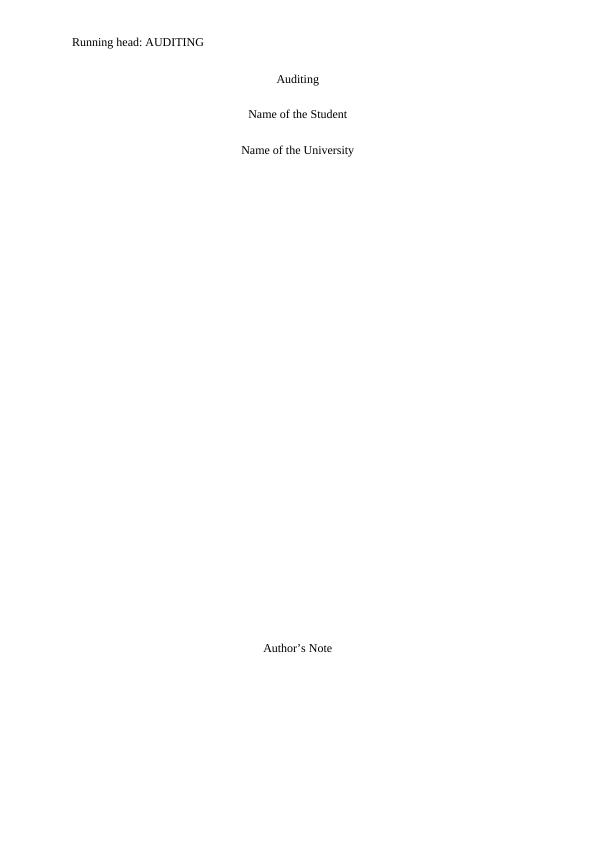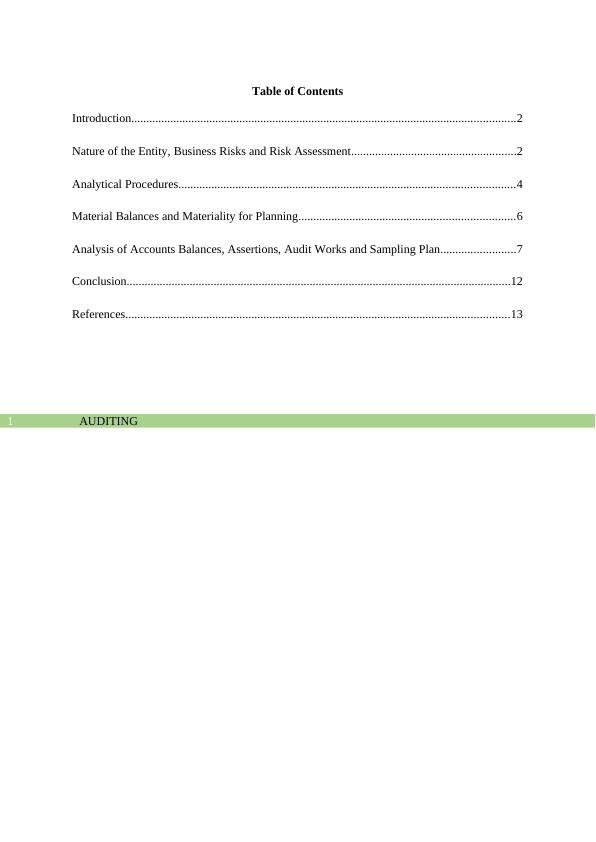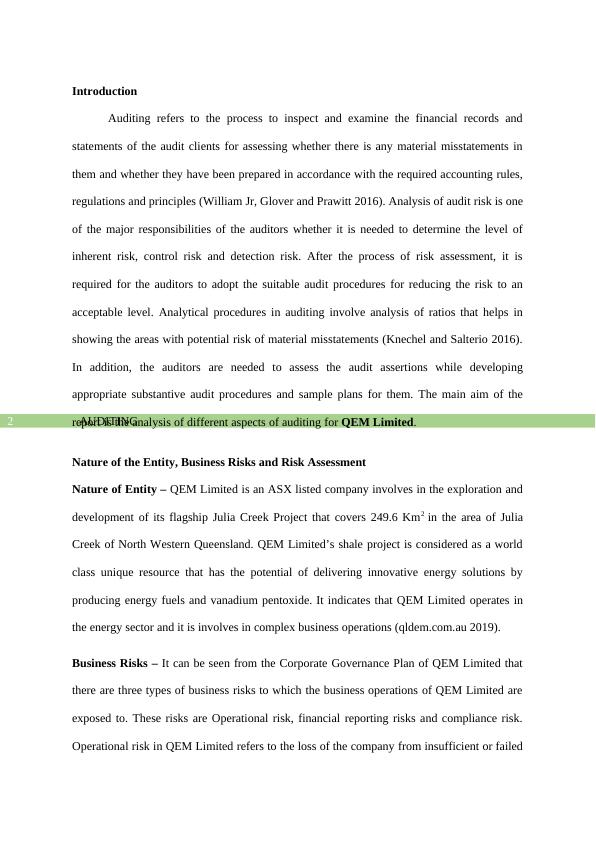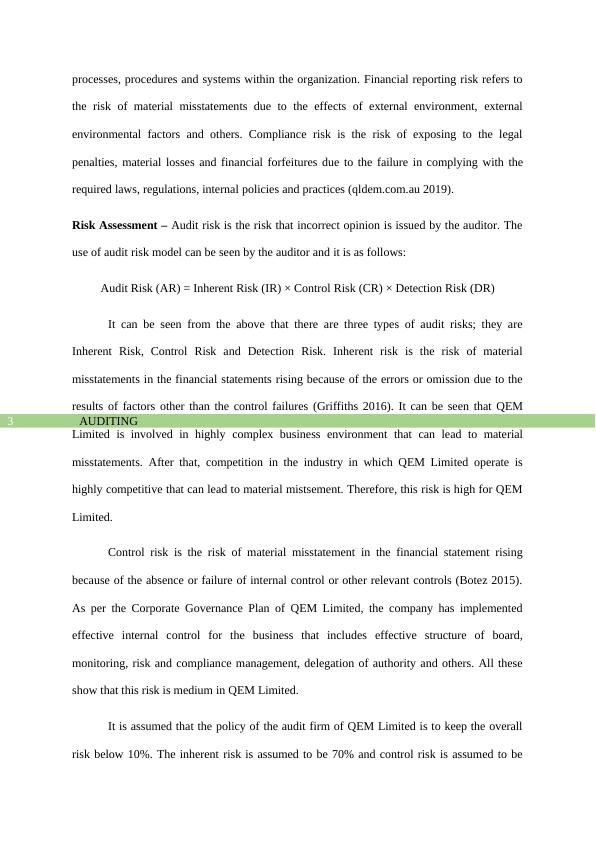Auditing: Nature of Entity, Business Risks and Risk Assessment
Added on 2022-11-29
18 Pages4182 Words438 Views
Running head: AUDITING
Auditing
Name of the Student
Name of the University
Author’s Note
Auditing
Name of the Student
Name of the University
Author’s Note

AUDITING1
Table of Contents
Introduction................................................................................................................................2
Nature of the Entity, Business Risks and Risk Assessment.......................................................2
Analytical Procedures................................................................................................................4
Material Balances and Materiality for Planning........................................................................6
Analysis of Accounts Balances, Assertions, Audit Works and Sampling Plan.........................7
Conclusion................................................................................................................................12
References................................................................................................................................13
Table of Contents
Introduction................................................................................................................................2
Nature of the Entity, Business Risks and Risk Assessment.......................................................2
Analytical Procedures................................................................................................................4
Material Balances and Materiality for Planning........................................................................6
Analysis of Accounts Balances, Assertions, Audit Works and Sampling Plan.........................7
Conclusion................................................................................................................................12
References................................................................................................................................13

AUDITING2
Introduction
Auditing refers to the process to inspect and examine the financial records and
statements of the audit clients for assessing whether there is any material misstatements in
them and whether they have been prepared in accordance with the required accounting rules,
regulations and principles (William Jr, Glover and Prawitt 2016). Analysis of audit risk is one
of the major responsibilities of the auditors whether it is needed to determine the level of
inherent risk, control risk and detection risk. After the process of risk assessment, it is
required for the auditors to adopt the suitable audit procedures for reducing the risk to an
acceptable level. Analytical procedures in auditing involve analysis of ratios that helps in
showing the areas with potential risk of material misstatements (Knechel and Salterio 2016).
In addition, the auditors are needed to assess the audit assertions while developing
appropriate substantive audit procedures and sample plans for them. The main aim of the
report is the analysis of different aspects of auditing for QEM Limited.
Nature of the Entity, Business Risks and Risk Assessment
Nature of Entity – QEM Limited is an ASX listed company involves in the exploration and
development of its flagship Julia Creek Project that covers 249.6 Km2 in the area of Julia
Creek of North Western Queensland. QEM Limited’s shale project is considered as a world
class unique resource that has the potential of delivering innovative energy solutions by
producing energy fuels and vanadium pentoxide. It indicates that QEM Limited operates in
the energy sector and it is involves in complex business operations (qldem.com.au 2019).
Business Risks – It can be seen from the Corporate Governance Plan of QEM Limited that
there are three types of business risks to which the business operations of QEM Limited are
exposed to. These risks are Operational risk, financial reporting risks and compliance risk.
Operational risk in QEM Limited refers to the loss of the company from insufficient or failed
Introduction
Auditing refers to the process to inspect and examine the financial records and
statements of the audit clients for assessing whether there is any material misstatements in
them and whether they have been prepared in accordance with the required accounting rules,
regulations and principles (William Jr, Glover and Prawitt 2016). Analysis of audit risk is one
of the major responsibilities of the auditors whether it is needed to determine the level of
inherent risk, control risk and detection risk. After the process of risk assessment, it is
required for the auditors to adopt the suitable audit procedures for reducing the risk to an
acceptable level. Analytical procedures in auditing involve analysis of ratios that helps in
showing the areas with potential risk of material misstatements (Knechel and Salterio 2016).
In addition, the auditors are needed to assess the audit assertions while developing
appropriate substantive audit procedures and sample plans for them. The main aim of the
report is the analysis of different aspects of auditing for QEM Limited.
Nature of the Entity, Business Risks and Risk Assessment
Nature of Entity – QEM Limited is an ASX listed company involves in the exploration and
development of its flagship Julia Creek Project that covers 249.6 Km2 in the area of Julia
Creek of North Western Queensland. QEM Limited’s shale project is considered as a world
class unique resource that has the potential of delivering innovative energy solutions by
producing energy fuels and vanadium pentoxide. It indicates that QEM Limited operates in
the energy sector and it is involves in complex business operations (qldem.com.au 2019).
Business Risks – It can be seen from the Corporate Governance Plan of QEM Limited that
there are three types of business risks to which the business operations of QEM Limited are
exposed to. These risks are Operational risk, financial reporting risks and compliance risk.
Operational risk in QEM Limited refers to the loss of the company from insufficient or failed

AUDITING3
processes, procedures and systems within the organization. Financial reporting risk refers to
the risk of material misstatements due to the effects of external environment, external
environmental factors and others. Compliance risk is the risk of exposing to the legal
penalties, material losses and financial forfeitures due to the failure in complying with the
required laws, regulations, internal policies and practices (qldem.com.au 2019).
Risk Assessment – Audit risk is the risk that incorrect opinion is issued by the auditor. The
use of audit risk model can be seen by the auditor and it is as follows:
Audit Risk (AR) = Inherent Risk (IR) × Control Risk (CR) × Detection Risk (DR)
It can be seen from the above that there are three types of audit risks; they are
Inherent Risk, Control Risk and Detection Risk. Inherent risk is the risk of material
misstatements in the financial statements rising because of the errors or omission due to the
results of factors other than the control failures (Griffiths 2016). It can be seen that QEM
Limited is involved in highly complex business environment that can lead to material
misstatements. After that, competition in the industry in which QEM Limited operate is
highly competitive that can lead to material mistsement. Therefore, this risk is high for QEM
Limited.
Control risk is the risk of material misstatement in the financial statement rising
because of the absence or failure of internal control or other relevant controls (Botez 2015).
As per the Corporate Governance Plan of QEM Limited, the company has implemented
effective internal control for the business that includes effective structure of board,
monitoring, risk and compliance management, delegation of authority and others. All these
show that this risk is medium in QEM Limited.
It is assumed that the policy of the audit firm of QEM Limited is to keep the overall
risk below 10%. The inherent risk is assumed to be 70% and control risk is assumed to be
processes, procedures and systems within the organization. Financial reporting risk refers to
the risk of material misstatements due to the effects of external environment, external
environmental factors and others. Compliance risk is the risk of exposing to the legal
penalties, material losses and financial forfeitures due to the failure in complying with the
required laws, regulations, internal policies and practices (qldem.com.au 2019).
Risk Assessment – Audit risk is the risk that incorrect opinion is issued by the auditor. The
use of audit risk model can be seen by the auditor and it is as follows:
Audit Risk (AR) = Inherent Risk (IR) × Control Risk (CR) × Detection Risk (DR)
It can be seen from the above that there are three types of audit risks; they are
Inherent Risk, Control Risk and Detection Risk. Inherent risk is the risk of material
misstatements in the financial statements rising because of the errors or omission due to the
results of factors other than the control failures (Griffiths 2016). It can be seen that QEM
Limited is involved in highly complex business environment that can lead to material
misstatements. After that, competition in the industry in which QEM Limited operate is
highly competitive that can lead to material mistsement. Therefore, this risk is high for QEM
Limited.
Control risk is the risk of material misstatement in the financial statement rising
because of the absence or failure of internal control or other relevant controls (Botez 2015).
As per the Corporate Governance Plan of QEM Limited, the company has implemented
effective internal control for the business that includes effective structure of board,
monitoring, risk and compliance management, delegation of authority and others. All these
show that this risk is medium in QEM Limited.
It is assumed that the policy of the audit firm of QEM Limited is to keep the overall
risk below 10%. The inherent risk is assumed to be 70% and control risk is assumed to be

End of preview
Want to access all the pages? Upload your documents or become a member.
Related Documents
Auditing for QEM Limitedlg...
|12
|2123
|219
Business Risks of Woodside Petroleumlg...
|18
|4115
|22
Auditing of Vodafone Australia: Key Business Risks and Risk of Material Misstatementlg...
|9
|1456
|442
ASA315: ANALYSIS AND DETERMINATION OF MATERIAL MISSTATEMENT RISKlg...
|7
|296
|31
Auditing and Assurance in Australialg...
|20
|4037
|106
Audit Procedures for SBL: Inherent and Control Risklg...
|6
|1459
|145